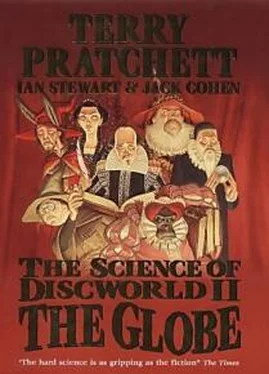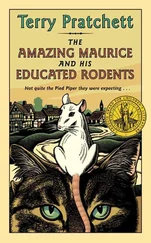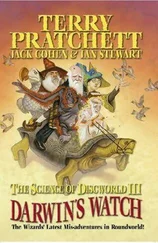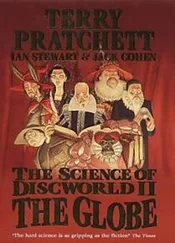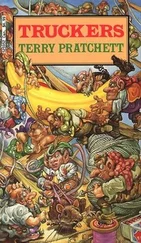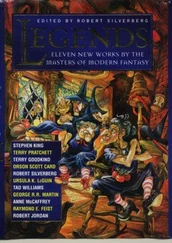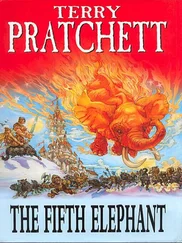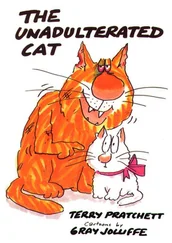Terry Pratchett - The Science of Discworld II - The Globe
Здесь есть возможность читать онлайн «Terry Pratchett - The Science of Discworld II - The Globe» весь текст электронной книги совершенно бесплатно (целиком полную версию без сокращений). В некоторых случаях можно слушать аудио, скачать через торрент в формате fb2 и присутствует краткое содержание. Жанр: Фантастика и фэнтези, на английском языке. Описание произведения, (предисловие) а так же отзывы посетителей доступны на портале библиотеки ЛибКат.
- Название:The Science of Discworld II - The Globe
- Автор:
- Жанр:
- Год:неизвестен
- ISBN:нет данных
- Рейтинг книги:5 / 5. Голосов: 1
-
Избранное:Добавить в избранное
- Отзывы:
-
Ваша оценка:
- 100
- 1
- 2
- 3
- 4
- 5
The Science of Discworld II - The Globe: краткое содержание, описание и аннотация
Предлагаем к чтению аннотацию, описание, краткое содержание или предисловие (зависит от того, что написал сам автор книги «The Science of Discworld II - The Globe»). Если вы не нашли необходимую информацию о книге — напишите в комментариях, мы постараемся отыскать её.
The Science of Discworld II - The Globe — читать онлайн бесплатно полную книгу (весь текст) целиком
Ниже представлен текст книги, разбитый по страницам. Система сохранения места последней прочитанной страницы, позволяет с удобством читать онлайн бесплатно книгу «The Science of Discworld II - The Globe», без необходимости каждый раз заново искать на чём Вы остановились. Поставьте закладку, и сможете в любой момент перейти на страницу, на которой закончили чтение.
Интервал:
Закладка:
From the hills of northern India to Tibet and China, and down into Africa, these forests held a great variety of small apes, ranging from about half the size of chimpanzees to the size of gorillas. The apes were at home on the ground and in the lower branches of the forest, and they were so common that today we have many fossils of them. In addition, the Old World monkeys were starting to diversify in the upper levels of the forest. Earth was a Monkey Planet.
But also a Snake Planet, a Big Cat Planet, a Nematode Planet, an Alga Planet and a Grass Planet.
Not to mention Plankton Planet, Bacterium Planet and Virus Planet. The elf might not have noticed that the African apes had produced several ground-dwelling kinds, not very different from the monkey-derived baboons. And it might also have failed to spot the presence of gibbons in the high branches, alongside the monkeys. These creatures were not particularly remarkable against a background of spectacular large mammals like rhinoceroses, a variety of forest elephants, bears. But we humans are interested in them, because they were our ancestors.
We call them 'woods-apes', dryopithecines. Some, known as Ramapithecus, were of lighter build
-the jargon is 'gracile'. Others, such as Sivapithecus, were big and strong -'robust'. The lineage of Sivapithecus was the one that led to orangutans. These early apes would have been shy, morose creatures like today's wild apes, occasionally playful, but the adults would have been very belligerent and conscious of status within the group.
The forests inhabited by the woods-apes slowly dwindled as the climate cooled and dried, and grasslands -savannah country -took over. There were ice ages, but in the region of the tropics these did not reduce temperatures severely. However, they did change the patterns of rainfall.
The monkeys thrived, producing many ground-living kinds like baboons and vervets, and the ape populations got smaller.
By ten million years ago, there were few apes left. There are almost no fossil apes from that period. It seems plausible that, as now and as previously, those apes that did still exist were forest creatures. Some, like today's chimpanzees, gorillas and orangutans, were probably common in a few locations in the forests, but you'd have needed a lot of luck to find them. The observing elf might, even then, have put all of these apes on its Endangered List of Earth Mammals. Like very nearly all animal groups that had evolved, the forest apes were soon to be history rather than ecology. The common ancestor of humans and chimpanzees was, then, a not very remarkable ape that probably lived much as the different chimpanzees do now: some in flooded forest like today's bonobos, some in rain-forest, and some in fairly open woodland grading into grasslands. The gorilla lineage separated from the other apes around this time.
At first, the elf would probably not have been very interested as -according to one of the two popular theories of human origins - a new kind of ape began to evolve a more upright stance than those of its relatives, lost its hair, and moved out on to the savannah. Many other mammals did the same; there was a new kind of living to be made on the great grass plains. Giant hyenas, massive wild dogs, lions and cheetahs made a good living from the vast herds of herbivores that lived on the productive savannah grasses; the giant pythons were probably originally savannah animals, too.
The story has been told many times, in many versions. And that's just the point: we understand our ancestry through story. We wouldn't be able to work out our ancestry from the fossils that we have discovered unless we'd learned just what clues to look for, especially since few fossil sites have enough evidence left.
The new ancestral plains ape saw the world differently. Judging from the behaviour of today's chimpanzees, especially bonobos, it was a highly intelligent animal. We call their fossils southern apes, australopithecines, and there are hundreds of books that tell stories about them.
They may have sojourned by the sea, doing clever things on beaches. Some certainly lived on lake margins. Today's chimpanzees use stones to smash hard nuts open, and sticks to extract ants from nests; the australopithecines also used stones and sticks as tools, rather more so than their cousins the chimpanzees now do. They may have killed small game, as chimpanzees do. They probably used sexual behaviour to hang much of their pleasure on, like today's bonobos, but most likely they were more gender-conscious and male-dominant. Like previous apes, they diverged into gracile and robust lines. The robust ones, called Anthropithecus boisi, or even a different genus Zinjanthropus ('nutcracker man') and other defamatory names, were vegetarians like today's gorillas, and probably left no descendants in modern times.
This kind of split into gracile and robust forms, by the way, seems to be one of the standard patterns of evolution. Mathematical models suggest that it probably happens when a mixed population of big and small creatures can exploit the environment more effectively than a single population of medium-sized ones, but this idea has to be considered highly speculative until more evidence comes in. The zoological world was recently given a reminder of how common such a split is, and of how little we really know about the creatures of our own planet.
The animal involved could not have been better known, nor more appropriate to Discworld: the elephant [34] There's been a very cute discovery about elephants recently, and the only place we can find to put it is this footnote. (This, after all, is what footnotes are for.) It has been known since 1682 that elephants' lungs are unusual, without the 'pleural cavity', a space between the lungs and the chest wall that is filled with fluid, that most mammals have. Instead of fluid, elephants' lungs are surrounded by loose connective tissue. It now looks as if this type of lung exists because it lets elephants go snorkelling, breathing through their trunks. In 2001 the physiologist John West calculated that with a normal pleural cavity, the pressure of the water would burst the tiny blood vessels in the pleural membrane and snorkelling could be fatal. We're now wondering whether the trunk evolved in the ocean as a snorkel. Land vertebrates first evolved from fish that came up on to the seashore. Much later, a variety of mammals went back into the oceans and evolved into several kinds of sea-mammals, the most spectacular modern descendants being whales. We now see that somewhere along the way, some of those water-adapted mammals came back on to the land and turned into elephants. So the elephant is now on its second evolutionary journey out of the water and on to the land. It would be nice if it made up its mind.
. As every child learns at an early age, there are two kinds of elephant, two distinct species: the African elephant and the Indian elephant.
Not so. There are three species. Zoologists have been arguing for at least a century about what they thought was at most a subspecies of 'the' African elephant Loxodonta africana. The typical big, burly African elephant lives on the savannah. The elephants that live in the forest are shy, and difficult to spot: there is just one of them in the Paris zoo, for example. Biologists had assumed that because the forest elephants and the savannah elephants can interbreed at the edges of the forest, they could not be separate species. After all, the standard definition of a species, promoted by the evolutionary biologist Ernst Mayr, is 'able to interbreed'. So they either insisted that there was just one species, or that 'African elephant' had a distinguished subspecies, the forest elephant Loxodonta africana cyclotis. On the other hand, zoologists who have had the good fortune to see forest elephants are in no doubt that they look very different from the savannah ones: they are smaller, with straighter, longer tusks, and round ears, not pointed ones.
Читать дальшеИнтервал:
Закладка:
Похожие книги на «The Science of Discworld II - The Globe»
Представляем Вашему вниманию похожие книги на «The Science of Discworld II - The Globe» списком для выбора. Мы отобрали схожую по названию и смыслу литературу в надежде предоставить читателям больше вариантов отыскать новые, интересные, ещё непрочитанные произведения.
Обсуждение, отзывы о книге «The Science of Discworld II - The Globe» и просто собственные мнения читателей. Оставьте ваши комментарии, напишите, что Вы думаете о произведении, его смысле или главных героях. Укажите что конкретно понравилось, а что нет, и почему Вы так считаете.
